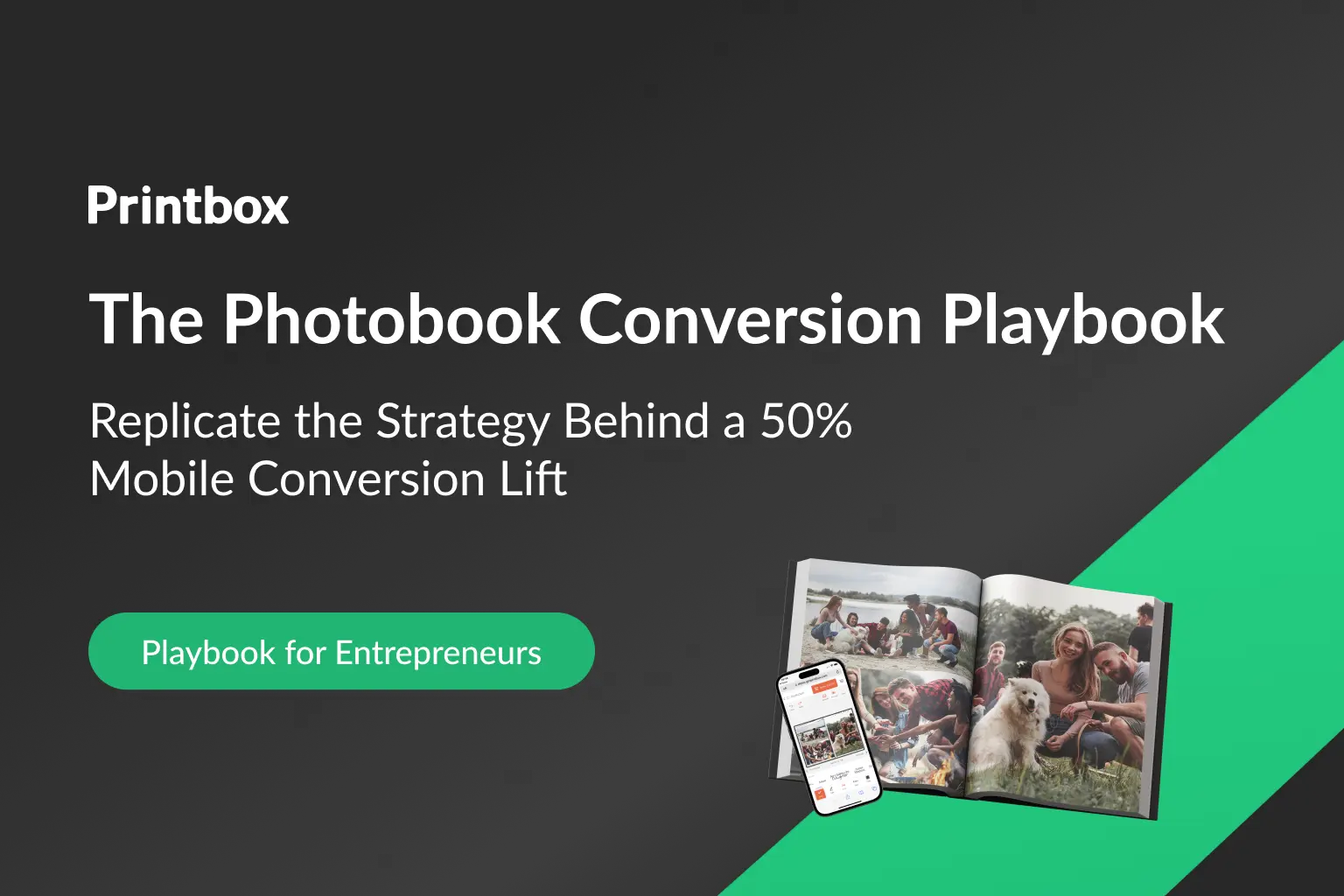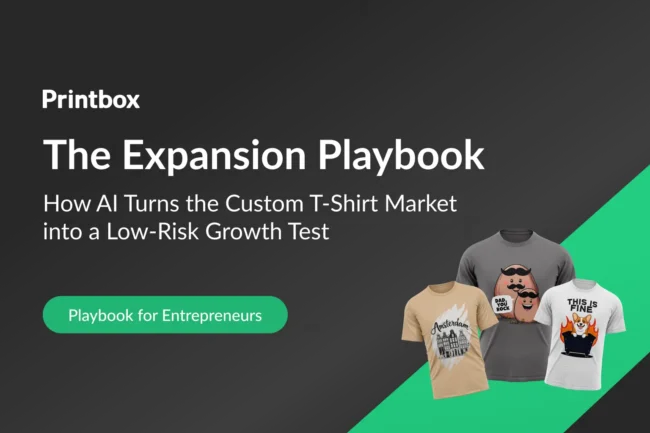The Photobook Conversion Playbook: From Abandoned Projects to Increased AOV with AI
Executive Summary
Who is this playbook for? For e-commerce leaders and product managers in the personalization industry who are responsible for conversion and user experience, and whose current tools struggle with the scale and complexity of photoproducts.
- Problem: High traffic to photoproduct pages isn’t converting. Customers abandon projects in the editor due to decision paralysis (the ‘paradox of choice’) and frustration, especially on mobile. The result is lost revenue from already paid-for traffic (CAC).
- Thesis: The key to conversion growth isn’t more features, but reducing friction in the creation process. AI, through automatic project generation (‘Smart First Draft’), eliminates ‘blank page syndrome,’ turns frustration into a ‘wow’ effect, and unlocks mobile conversion. A case study confirms a 50% increase in mobile conversion after implementing this strategy.
- Risk of Inaction: Maintaining legacy technology leads to two strategic bottlenecks: performance (instability and lost sales during peak season) and innovation (technical debt slowing down time-to-market). As a result, the company loses revenue and market position to more agile competitors.
- Recommended Next Step (30-60 Days): Diagnose the in-editor funnel to identify the main drop-off point (likely after photo upload). Run an A/B test comparing the current process with a new one based on ‘Smart First Draft’. Measure the increase in Project Completion Rate, AOV, and the reduction of the mobile vs. desktop conversion gap to build a solid business case for further investment.
Your analytics show high traffic to your photobook pages, but the conversion rate is disappointing. Your customers upload hundreds of photos to the editor, then disappear. This isn’t just another abandoned cart. It’s decision paralysis caused by task complexity.
This playbook shows how to use AI to transform that frustrating process into a seamless, high-converting experience – and recapture lost sales.
The Business Potential: How AI Solves the Paradox of Choice in Personalization
Business leaders often assume that more features, options, and design flexibility lead to a better product. However, this intuitive thinking often triggers the “paradox of choice”. Overwhelmed by countless possibilities, the customer experiences decision paralysis and abandons the process, even if they like the product.
For an experienced e-commerce leader, AI is a strategic tool that solves this fundamental problem. Here are three ways AI transforms decision paralysis into higher conversion:
1. Breaking the Creation Barrier
The main conversion killer in photo product editors is the blank page syndrome. AI, through automatic project creation features, completely eliminates this barrier. Instead of forcing the customer to make hundreds of decisions upfront, the system provides them with a beautiful, finished draft. Their role changes from the performer of a tedious task to a creative decision-maker, which drastically lowers the entry threshold for the creation process.
2. Creating an Emotional “Hook” (The WOW Effect)
The moment when the “chaos of hundreds of photos turns into a finished project in seconds” is a powerful emotional trigger. Instead of frustration, the customer feels satisfaction and amazement. This positive experience builds momentum that motivates them not only to complete the purchase but also to invest further in the project (e.g., by adding more pages), which directly increases the average order value (AOV).
3. Enabling Effective Mobile Creation
The paradox of choice is particularly severe on a small screen. Manually managing hundreds of photos and options on a smartphone is practically impossible and leads to massive project abandonment. Smart AI features that automate the most complex tasks are crucial to making the photobook creation process feasible and enjoyable on mobile devices, which unlocks the potential of this most important traffic segment.

The Playbook: How to Implement an AI-Powered Conversion Optimization Strategy in 4 Steps
Understanding these models for success is the first step. The key, however, is to translate this strategic knowledge into concrete, measurable actions that can be taken within your organization. The following plan is designed to help with that.
Step 1: Diagnose the Friction Points
Strategic Goal: To identify how much revenue is lost due to the “creation barrier” and use this data to justify investment.
🎯 Actionable Tactics:
- In-Editor Funnel Analysis: With the “paradox of choice” in mind, the in-editor funnel analysis becomes a tool for precisely diagnosing “cognitive overload points.” Unlike a simple e-commerce funnel, the journey in personalization looks like this:
Start a project → upload photos → interact with the layout (e.g., change a template, add pages) → place the first photos → finalize the project (e.g., edit the cover, preview) → add to cart.
Analyzing the drop-offs at each of these stages allows you to understand exactly where decision paralysis hits hardest:
- Drop-off between photo upload and layout interaction: This is a classic symptom of the “paradox of choice” in action. The customer has already invested effort but is faced with a blank project, which generates maximum cognitive overload. This is where the largest portion of potential revenue is lost, as the customer gives up before making any creative decisions.
- Drop-off during the photo placement stage: This problem is executional frustration. It means the customer overcame the initial barrier, but the tedious and time-consuming nature of the process itself (manually dragging hundreds of photos) causes them to lose patience and energy.
- Drop-off at the finalization stage: This is a “last mile” problem. It may signal that more advanced options, like cover editing, are too complex, or that there is no clear call to the next step, creating a final, unnecessary barrier.
Identifying which of these stages generates the highest losses enables you to make a precise, data-driven decision about whether the main issue lies in decision paralysis at the start or frustration during the editing process.
- User Behavior Analysis: Use session recording tools (e.g., Hotjar, Clarity) to see how real users behave in the editor. Look for signals of frustration: multiple attempts to drag an element, rapid up-and-down scrolling (“rage scrolling”), or sudden page exits after encountering a difficulty.
🧠 Key Questions to Ask Your Team:
- “At which specific step in the photobook editor do we lose the most users?”
- “What is the financial cost of this drop-off per month, considering our customer acquisition cost (CAC)?”
- “How does our mobile project completion rate compare to desktop, and what is the associated revenue gap?”
⚠️ Common Pitfall: Focusing on general e-commerce metrics (like homepage bounce rate) instead of analyzing micro-behaviors within the editor, where the real problem occurs.
Step 2: Implement a “Smart First Draft” Strategy
Strategic Goal: To radically reduce the customer’s time-to-value by eliminating the biggest barrier: the blank page syndrome.
🎯 Actionable Tactics:
- Automated Initial Layout as a Breakthrough Point: The key is to implement a feature that, once the customer uploads their photos, automatically analyzes them and arranges them into an aesthetically pleasing, complete photobook design. This is the “wow” moment that fundamentally changes the psychology of the process. The customer is no longer overwhelmed by a task requiring hundreds of small decisions — they become a curator refining a beautiful, already-existing piece. Instead of acting as a technical operator, the customer becomes a true designer.
- Personalized First Draft Based on Understanding: To take this feature further, use AI to analyze photo metadata (dates, locations, or even face grouping). This enables the system to build an initial draft in chronological order, with chapters reflecting different stages of a journey or event. It shows the customer that the system didn’t just mechanically place their photos – it understood their story, which immediately builds trust and engagement.
🧠 Key Questions to Ask Your Team:
- “How can we measure the reduction in ‘time-to-first-meaningful-project’?”
- “Does the automatically generated project align with our brand’s aesthetic, or does it look generic?”
- “What is the simplest version of this feature (MVP) that we can test first?”
⚠️ Common Pitfall: Creating a “locked-in” design that frustrates users who want to make small tweaks. The key is automation that leaves the customer in full control of the final result.
Step 3: Maintain Creative Momentum (Smart Editing Support)
Strategic Goal: To maintain the customer’s creative momentum and guide them smoothly toward completion, minimizing further friction points after the first draft is created.
🎯 Actionable Tactic:
- Contextual Suggestions as “Micro-Frustration” Eliminators: Once the first draft is ready, the goal is to maintain the customer’s creative momentum. The biggest threat now is the minor, repetitive frustration of manual adjustments. Therefore, it is crucial to implement features that intelligently suggest alternative, aesthetically balanced layouts for each page based on the number and orientation of photos placed there. Instead of forcing users to “tinker” manually, the system should proactively propose 2–3 best options. This not only speeds up the process but also gives the customer a sense of control and competence, which boosts their satisfaction and motivation to complete the project.
🧠 Key Questions to Ask Your Team:
- “Which editor feature generates the most user errors or ‘undo’ actions, and how can AI simplify it?”
- “How can we use AI to guide, not command, the user’s creative choices?”
⚠️ Common Pitfall: Overloading the editor with too many “smart gadgets”, which creates a new form of complexity and slows down the tool, defeating the original purpose of simplification.
Step 4: Measure and Validate the ROI
Strategic Goal: To build a clear, data-backed business case for further investment in AI technology and platform optimization.
🎯 Actionable Tactics:
- A/B Test: The Old vs. New World: To build a strong business case, conduct a rigorous A/B test. Compare the user journey in the old, manual editor (Group A) with the new AI-assisted process (Group B). It’s crucial that both groups come from the same traffic sources, to isolate the effect of user experience improvements.
- Measure Beyond Conversion: In addition to the final conversion rate, track key leading indicators that tell the full story:
- Project Completion Rate: The most important metric, directly measuring whether you’ve solved the “creation barrier” problem.
- Average Time to Complete a Project: Evidence of improved efficiency and reduced frustration.
- Customer Support Inquiries: A decrease here means direct operational cost savings.
- AOV and LTV: The ultimate business metrics that reveal whether happier customers spend more and return more often.
🧠 Key Questions to Ask Your Team:
- “What is the exact percentage lift in project completion rate and AOV in the AI group?”
- “How has this change impacted the conversion gap between mobile and desktop?”
- “Based on these results, what is the projected 12-month return on investment (ROI) for this initiative?”
⚠️ Common Pitfall: Focusing solely on the final conversion rate while ignoring leading indicators (like project completion rate), which can provide a clearer picture of user engagement.
This 4-step model provides a strategic framework for action. The natural next step is to ask about the technology that enables it without causing operational chaos.
This is where the right platform becomes your unfair advantage. See how Printbox’s generative AI, integrated editors, and conversion-focused features can bring this entire playbook to life.
➡️ Book a strategic demo to explore how you can solve the conversion problem and recapture lost revenue.
The Technological Advantage: Why Your Current System Might Be the Problem
At first glance, your current system may seem sufficient. However, when trying to implement advanced, AI-driven solutions to fix the “creation barrier,” two fundamental problems that act as a brake on growth often emerge.
1. The Performance Bottleneck: The Scalability Problem During Peak Season
Supporting advanced AI features while simultaneously processing hundreds of photos from thousands of users in real-time is an immense load. Many older, monolithic architectures were not designed for such tasks. As a result, at the most critical moment – during a sales peak like Black Friday – your editor slows down, and the site becomes unstable. This is every e-commerce leader’s nightmare: you invest in marketing to drive traffic, only to lose sales because your technology can’t handle it. A modern, scalable architecture is therefore not a “nice-to-have” feature, but the foundation that ensures revenue predictability and protects your brand’s reputation at key moments.
2. The Innovation Bottleneck: The Cost of “Technical Debt”
If your current platform is rigid, every attempt to implement innovations like AI turns into a costly and time-consuming development project. This is precisely “technical debt” – the price you pay for the limitations of your old system. While you and your team struggle to integrate one new feature over many months, agile competitors are able to test three new ideas in the same amount of time. As a result, instead of setting trends, you start chasing the market. A flexible platform is a strategic matter of speed and adaptability (“time-to-market”). It allows for the rapid implementation and testing of new solutions, which is crucial in the fight to maintain a competitive edge.

Social Proof: Real-World Optimization Results
Theory is one thing, but hard market data provides the ultimate proof. Let’s look at a real-world example. One of our partners, a leading photo product company in the Thai market, faced a critical business challenge. Their analytics showed that over 55% of their customers were mobile users, yet they observed a significant drop-off in conversion for photobooks on these devices. The complex, multi-step creation process was simply too cumbersome on a small screen, leading to high project abandonment rates.
Instead of trying minor UI tweaks, they implemented a strategic solution: an AI-powered Smart Creation feature. This tool automatically generates the first, complete draft of a photobook seconds after a user uploads their photos.
The results were immediate and substantial. The company recorded a 50% increase in mobile conversion for photobooks compared to the previous editor-only approach. This case is a powerful testament to a simple truth: investing in technology that reduces creative friction is one of the most direct ways to recapture lost revenue.
“Mature companies often hit a growth ceiling on existing traffic. In that situation, we take a two-track approach: open new demand through product innovation and optimize current flows by reducing creation friction. Our Customer Success team runs funnel diagnostics (editor completion rate, time to first draft [TTFD], mobile drop-offs), builds a hypothesis backlog, and executes iterative A/B tests on the highest-impact bottlenecks. The goal is to move conversion and ROI predictably with data-driven decisions, rather than cosmetic UI tweaks.”
Agnieszka Sadowska, Chief Customer Officer at Printbox
Summary and Your Next Step
Abandoned projects in the editor are not your customers’ fault. They are a symptom of legacy technology that can’t handle the complexity of the creation process. Implementing AI is not a cost, but a strategic investment in higher conversion, a better customer experience, and recapturing the revenue you are already losing.
If you want to learn more, follow our blog and our analysis on LinkedIn to regularly receive practical advice and strategies for the personalization industry. However, if you would prefer to immediately discuss how this model can be applied directly to your company, our team is ready to schedule a strategic consultation via our contact form.




